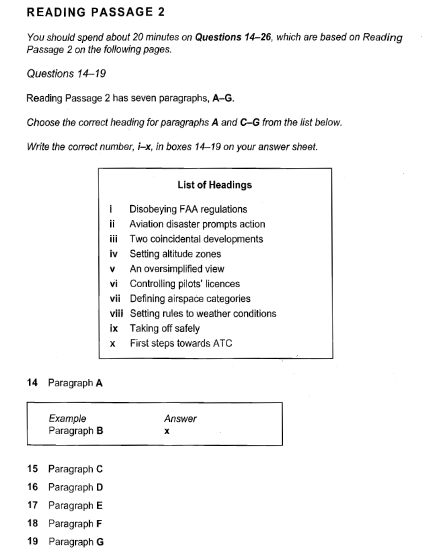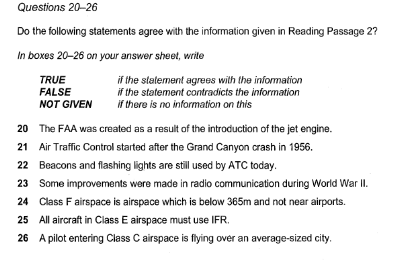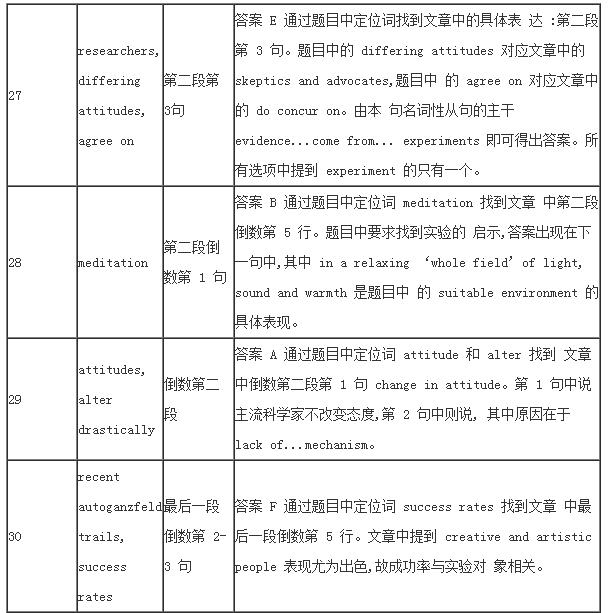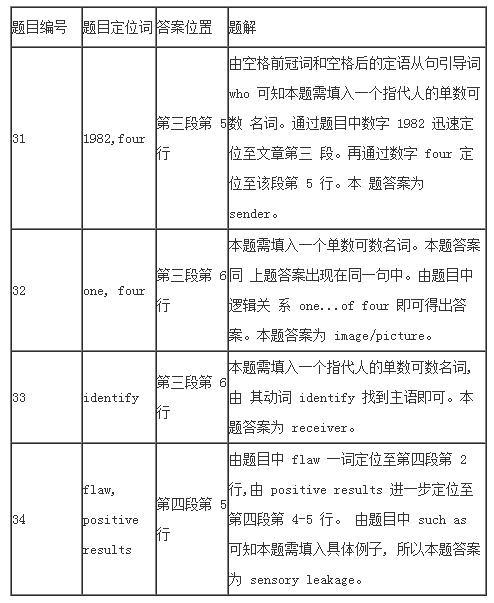剑桥雅思8阅读:Test1雅思阅读PASSAGE 2真题+答案+解析
发布时间:2020-11-20 关键词:AIR TRAFFIC CONTROL IN THE USA
A An accident that occurred in the skies ower the Grand Canyon in 1956 resultedin the establishment of the Federal Aviation Administration (FAA) to regulate andoversee the operation of aircraft in the skies over the United Stales, which werebecoming quite congested. The resulting struclure ol air tafic control has greatlyincreased the salety of flight in the United States, and similara air tafi controlprocedures are also in place ower much of the rest of the world,
B Rudimentary air trafic control (ATC) existed well before the Grand Canyon disaster.As early as the 1920s, the earliest air tafi onrolers manually guided aircraft inthe vicinity of the airports, using lights and flags, while beacons and flashing lightswere placed along cross-country routes to establish the ealiest airways. However,this purely visual systerm was useless in bad Weather, and, by the 1930s, radiocommunication was coming into use for ATC. The first region to have somethingapproximating today's ATC was New York City, with other major metropolitan areasfollowi ng soon ater.
C in the 1940s, ATC centres oould and did take advantage of the newly developedradar and improved radio communication brought about by the Second World War,but the systerm remained rudimentary. It was only after the creation ol the FAA thatfull-cale regulation of America's airspace took place, and this was fortuitus, forthe advent of the jet engine suddenly resulted in a large number of very fast planes,reducing ilots" margin of error and practically demanding some set Of rules to
keep everyone well separated and operating safely in the air.
D Many people think that ATC consists of a row of controllrs siting in frontợl theirradar screens at the nation's airports, tling ariving and departing raffic what todo. This is a very incomplete part of the picture. The FAA realised that the airspaceover the United States would at any time have many dffrentr kinds of planes, flyingfor many diferent purposes, in a variety of weather conditions, and the same kindof structure was needed to accommodate all of them.
E To meet this challenge, the fol lwing elements were put into effect. First, ATCextends over virtually the entire United States. In general, from 365m above theground and higher, the entire country is blanketed by controlled airspace. Incertain areas, mainly near airports, controlled airspace extends down to 215mabove the ground, and, in the immediate vicinity of an airport, all the way down tothe surface. Corolled airspace is that airspace in which FAA regulations apply.Elsewhere, in uncontrolled airspace, pilols are bound by fewer regulations. In thisway, the recreational pilot who simply wishes to go flying for a while without all the restrictions imposed by the FAA has only to stay in uncontrolled airspace, below365m, while the pilot who does want the protection aftorded by ATC can easilyenter the controlled airspace.
The FAA then recognised two types of operating environments. In good
meteorological conditions, flying would be permitted under Visual Flight Rules
(VFR), which suggests a strong reliance on visual cues to maintain anạcceptablelevel of safety. Poor visibility necessitated a set of Instrumental Flight Rules (IFR),under which the pilot relied on atituded and navigational infomation provided by theplane's instrument panel to fly safely. On a clear day, a pilot in controlled airspacecan choose a VFR or IFR flght plan, and the FAA regulations were devised in a waywhich accommodates both VFR and lFR operations in the same airspace. However,a pilot can only choose to fly IFR if they possess an instrument rating which is
above and beyond the basic pilot's license that must also be held.
G Controlled airspace is divided into several dillerent types, designated by lettersof the alphabet. Uncontrolled alirspace is designated Class F, while ontrolled
airspace below 5 490m above sea level and not in the vicinity of an airport is ClassE. All airspace above 5,490m is designated Class A, The reason for the divisionof Class É and Class A airspace stems from the type of planes operating in thern.Generally, Class E airspace is where one finds general aviation aircraft (few of
which can climb above 5,490m anyway), and commercial turboprop aircraft. Above5,490m is the realm of the heavy jets, since jet engines operate more effienly athigher altitudes. The difference between Class E and A airspace is that lin ClassA, all operations are IFR, and pilots must be instrument-rated, that is, silled andlicensed in aircraft instrumentation. This is because ATC control ol the entire
space is essential. Three other types of airspace, Classes D, C and B, govern thevicinity of airports. These correspond roughly to small municipal, medium-sizedmetropolitan and major metropolitan airports: respectively, and encompass anincreasi ngly rigorous set of regulations. For example, all a.VFR pilot has to do toenter Class C airspace is establish two -way radio contact with ATC. No explicit
permission from ATC to enter is needed, although the pilot must continue to obey allregulations goverming VFR flight. To enter Class B airspace, such as on approachto a major metropolitan airport, an explicit ATC clearance is required. The privatepilot who crulses without permission into this airspace risks losing their license.
美国航空交通管制
A. 1956年美国大峡谷上空发生的一起事故促成了联邦航空局(FAA)的成立。该局负责管理和监督美国越来越拥挤的天空。由此形成的空中交通管制结构大大增加了飞机在美国的飞行安全,世界其他地方也采取了类似的空中交通管制程序。
B.早在大峡谷灾难发生之前就存在雏形的航空交通管制(ATC)。早在20世纪20年代初,最早的空中交通管制员在机场附近用灯和标志旗手动引导飞机。当时,灯标和闪光灯沿着越野路线放置以建立最早的航线。然而,这种纯粹的视觉系统在恶劣天气情况下是无用的。到20世纪30年代,航空交通管制开始使用无线电通讯。采用类似于今天的航空交通管制的地方是纽约市,其他主要的大都市紧随其后。
C.20世纪40年代,航空交通管制中心利用了第二次世界大战催生出的新研制的雷达和改进后的无线电通讯技术,但管制系统仍然很不成熟。直到联邦航空局分创建以后,美国才开始进行全面的领空管制。而这一事件却是偶然的,因为喷气式发动机的产生突然导致大批飞机的出现。这些飞机减少了飞行员的误差幅度,并且需要实际的整套规则以使飞机之间保持良好的分离状态,在空中安全行驶。
D.人认为,航空交通管制就是一排管理人员坐在机场的雷达屏幕前指挥着抵港及离港的交通。这只是整个场景中的一部分。美国联邦航空局认识到每时每刻都会有许多不同种类的飞机,为了这样那样的目的,在各种各样的天气情况下飞行在美国的空中。因此,急需一个能够容纳所有情况的同一体系。
E.为了迎接这一挑战,美国联邦航天局实施了以下重要措施。首先,让航空交通管制几乎遍及整个美国。一般来说,离地面365米以及更高的地方,整个都被管制空域覆盖。在某些地区,主要是靠近机场的地带,管制空域扩大到自地面215米以上的范围,而在紧邻机场的区域,管制空域包括地面以上所有区域。管制空域是美国联邦航空局规定适用的空域。在其他非受控空域,飞行员受到的限制较少。如此一来,那些出于娱乐目的只想短时间飞行而不受美国联邦航空局规定限制的飞行员就只能停留在365米以下的非受控领空,而希望得到航空局保护的飞行员可以很容易地进人管制空域。
F.然后,美国联邦航空局确认了两种类型的飞行环境。在气象条件良好的情况下,飞行员可按照目视飞行规则(VPR)飞行。该规则主要依靠视觉线索来维持可接受的安全水平。低能见度使建立一套仪表飞行规则(IFR)成为必需。根据该规则,飞行员依靠飞机仪表盘提供的飞行高度和导航信息确保飞行安全。天气晴朗时,管制空域内的飞行员可以选择在目视飞行规则或仪表飞行规则下飞行,而美国联邦航空局 的规定在同一空域同时适用于两套规则的实施。但如果飞行员的仪表等级超出或低于了其必须持有的基本飞行员执照规定的等级,飞行员只能选择遵循仪表飞行规则。
G.管制空域分为几个不同的类型,以英文字母命名。非受控空域被定为F级,而海拔5490米以下非紧邻机 场的受控空域被定为E级。5490米以上的所有空域被定为A级。E级和A级是根据其间飞行的不同飞机类型而划分的。一般来说,通用航空飞机(这类飞机的飞行高度大多不超过5490米)和商业涡轮螺旋桨飞机在E级空域飞行。5490米以上是大型喷气机的领空,因为喷气式发动机的效率随着高度的增加而增高。E级和A级之间的区别在于A级空域中所有的操作都遵循仪表飞行规则,飞行员必须具有仪表级别,换言之,必须熟练掌握飞机仪表的使用并获得许可。因为航空交通管制对整个空域的控制是至关重要的。其他三个等级:D级、C级和B级用于管理机场附近的区域。这三个级别大致分别适用于小型城市、中等城市和大型城市的机场,包含了一套越来越严格的规章制度。例如,目视飞行规则飞行员如要进入C级空域,必须与航空交通管制建立双向无线电联系。航空交通管制无需提供明确的进人许可,但飞行员必须始终遵守在目视飞行规则下飞行的所有规定。如要进人B级空域,比如飞临主要城市机场,则必须有明确的航空交通管制许可。未经许可进入领空的私人飞行员可能会被吊销飞行执照。


剑桥雅思8阅读Test1Passage1原文+答案解析
体裁:说明讨论为主
主要内容:本文主要介绍关于心灵感应的研究。
结构:
第 1 段 :学者针对心灵感应进行科学试验。
第 2 段 :不同意见都认为 ganzfeld 实验可提供证据。
第 3 段 :详细介绍 ganzfeld 实验。
第 4 段 :ganzfeld 实验仍不能真正证明心灵感应的存在。
第 5 段 :介绍另一种实验——应用高科技的 autoganzfeld 实验。
第 6 段 :autoganzfeld 实验也有其不足之处。
第 7 段 :主流学术界对于心灵感应的态度。
第 8 段 :研究者不再致力搜寻证据,转而寻求心灵感应的原理。
师资点题剑桥雅思 8 阅读:
Questions 27-30
● 题型归类 :Matching 本题按文章顺序出题。

Questions 31-40
● 题型归类:Table 解答表格题目时,如题目表格中所给字数较多,可先用半分钟的时间仔细观察表格,待清楚表格大致内容及所需信息后,再行解题。以本表格为例,按照一般表格制表规律,先从左向右,再从上向下,表格各列分别标明实验时间、实验过程、实验结果、及实验不足之处。分为两行,则表明表格由两个不同时间的实验构成。
35or第四段第6行由题目中or一词可知本题与上题是并列 关系,确定了上一题的答案后,再通过文章中的from sensory leakage ... to outright fraud便可以很容易地确定答案。本题答案为outright fraud。
361987,key tasks第五段第2行由题目中的1987迅速定位至文章第5段,再由题目中的key tasks定位至该段第 2 行。根据which used computers to perform many of the key tasks such as... 可以确定本题答案为computers。 37limit 第五段第3行由题目中limit 定位至文章中第五段第3行minimising。 因该句中出现两minimising,由空格后面的定语in carrying out the tests可排除掉后面的 the risk of flawed results,也可通过题目要求NO MORE THAN THREE WORDS进行排除。本题答案为human involvement。38results, subjected to a 第五段倒数第2行由冠词a可知,本题需要填入一个单数可数名词。沿上道题答案继续向后在第4行找到 results。 通过文中的In 1987,results...were studied by Honorton in a‘meta-analysis’可以确定本题答案为meta-analysis。39flaw, different test results 第六段第1行由flaw一词定位至第六段第1句。段首的强转折词yet表明本段与上文所表达意思相对或相反。题目中的between different test results对应文章中的between individual ganzfeld studies,从而可以确定本题答案为lack of consistency。40fact,sample group,not 第六段第3行或倒数第3行本题需填入形容词。通过题目中的sample groups were not直接找逻辑关系即可在第6段倒数第3行中的the group is just not big enough找到答案big enough;或在本段第3行找到 fact,根据句子it takes large samples to detect small effects确定本题还可以填 large enough。所以本题答案为big/large enough。





